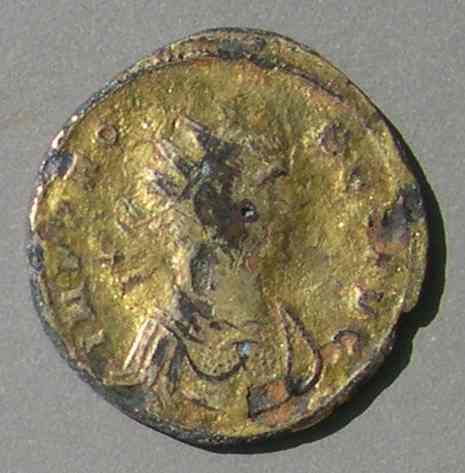

Imitation Aurei, Siliquae, and Solidi
Although this page emphasizes the second half of the 4th century, it begins with a gilt antoninianus and one rare imitation gold aureus, with gold foil wrapped over a lead (possibly silver?) core and then struck.
Probus (276-282) gilt antoninianus.


A common VICTORIA GERM trophy and two captives type, but gilt in antiquity.
21mm. 4.22 grams. 5:30.
RIC V.II 221/2.
This gilding does not make it very deceptive. It looks like it has worn through in places, but how would it get wear?
It could not have passed hands many times as genuine. If the gilding were done in mondern times, I doubt it would display the high-spot wear seen on the obverse. A mystery!
Maximian (AD 286-305); imitation aureus:
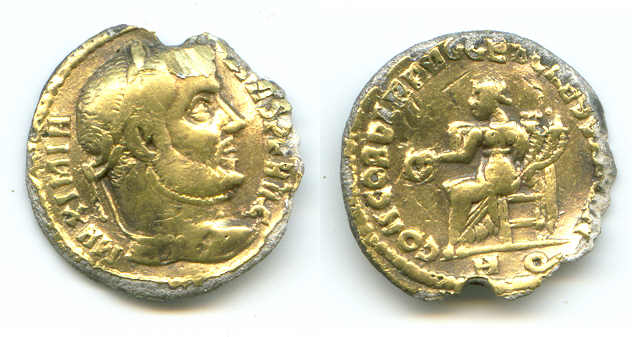
18 mm. 5:30. 3.55 grams. (Extremely light for an aureus.)
MAXIMIA-NVS PF AVG, laureate head right
/CONCORDIA AVGG ET CAESS NNNN, Concordia seated left, holding out patera, with double cornucopia in left, AQ in exergue
Ref: RIC VI Aquileia 2b "R3", which should be c. 5.3 grams. Although the style is excellent, it is hard to imagine this fooling anyone because gold is too valuable to accept without close scrutiny (either in ancient or modern times). Lead is dense, but not nearly as dense as gold, and this piece is simply too light in the hand.
Imitation Siliquae
Silver was issued in numerous rare varieties, but played little role in the coinage of the fourth century until the large issues of siliquae under Constantinus II in the 340's. Silver-plated imitation siliquae are very rare. Perhaps this is because the coins are so thin that only a small amount of silver in the core could be replaced by copper and still maintain a deceptive and complete silver plating. The profit potential is much less than for the earlier, thicker, denarii.
I have heard of only a few silver-plated imitation siliquae besides the one below.
Julian II (AD 355-360-363), siliqua:
18mm. 6:00. 2.05 grams.
An excellent example with silver-plating broken only on the reverse edge 10:00-12:00 and a tiny bit at 7:00.
The style is quite distinguishable from official issues.
FL CL IVLI-ANVS PP AC [Legend ends PP AC and not PF AVG]
pearl-diademed, draped, and cuirassed bust right. Julian is beardless.
VOT/V/MVLT/XX in wreath
TR in exergue
References: Sear 3970 variety as prototype. RIC Trier --, but 363-365 have VOTIS/V/MVLTIS/X and Lugdunum 231-235 have VOT/X/MVLT/XX (with no beard). Arles 309-311, plate 8, has a long wavy beard. Constantinople 159, plate 23 also has a wavy beard.
Valentinian I (AD 364-375):
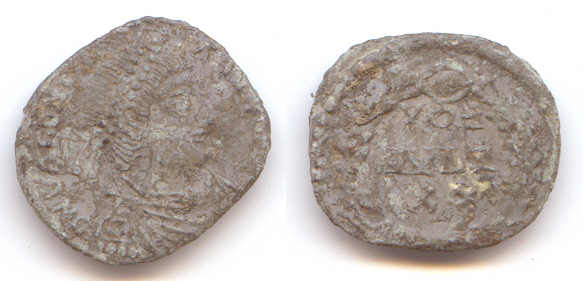
16-14mm. 1:00. 1.40 grams.
Very base metal and hard to see, but the type resembles a siliqua.
DN VALENTI[NI] ANVS [PF AVG], pearl-diademed bust right, clear lettering
VOT / MVLT / XX in three lines, inside wreath. Lettering good and wreath well-drawn.
mintmark off flan.
Ref: This reverse legend is not in RIC. The type is well-executed and literate, but must be of local British manufacture.
Provenence: The midlands of England.
Constantius II (AD 337-361), fourree gold solidus:
21mm. 12:00. 2.60 grams (very light -- the denomination should weigh 4.45 grams.)
Holded, probably to condemn it. Much of the gold is gone from the surface.
FL IVL CONSTAN - TIVS PERP AVG
Helmeted and curiassed bust facing, holding spear and shield, spear back across right shoulder
/GLORA REIPVBLICAE [illegible]
Roma and Constantinopolis seated, holding shield inscribed
VOT/XXX/MVLT/XXXX
The mintmark is too weak to make out. This type was minted c. 350-355 at most mints.
The weight of a geniune speciman would be 4.45-4.50 grams.
Sear 3988
I think it was pierced to condemn it as a fake.
Valentinian (AD 364-375), fourree gold solidus
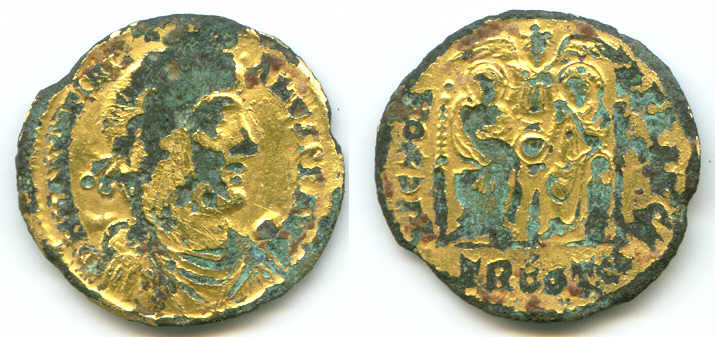 20mm. 6:00. 1.98 grams (extremely light for the denomination which should weigh c. 4.45 grams.)
20mm. 6:00. 1.98 grams (extremely light for the denomination which should weigh c. 4.45 grams.)
DN VALENTINI-ANVS PF AVG, pearl-daidemed, draped, and cuirassed bust right
/VICTOR-IA AVGG, two emperors (with Valens) seated facing, together holding a globe and behind and between them a Victory with outspread wings. Between them low, a palm branch.
In ex: TROBT
Prototype: Sear 4089, plate 12. RIC TRier 17b, AD 367-375.

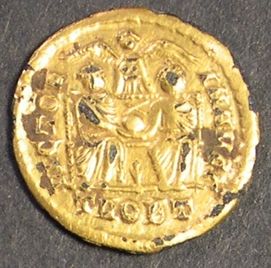
gilt 20 mm. 6:00. 2.38 grams.
This is far too light to be convincing,
but excellent style.
VICTORIA AVGG
TROBT in ex.
Type of RIC IX Trier 17b6, page 16 "367 - 375 AD"
Valens/Constantius II muled siliqua
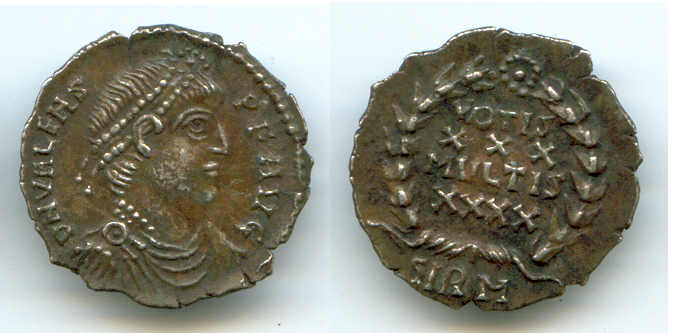
A ragged AR 18, with no sign of plating. 2.19 grams, which would be full weight for a Valens siliqua. Supposedly found in Tunisia. But, it is simply a modern fake.
When I first posted this, I wrote, "This is a wonderful and very unusual silver imitation. The obverse is of Valens with good lettering but slightly unoffical style. The reverse is of Constantius II. Of course, they should never have been paired."
However convincing it may be in isolation, I have now seen two more of the same "dies" and one of which was obviously not genuinely ancient -- it even looked cast. I suppose this coin could have been used as a host for casting, but I now think it is more likely that this one is a modern fake, too. I am convinced this piece is struck, not cast. It is much nicer than the other examples of the type.
DN VALENS - PF AVG , pearl diademed, draped, and cuirassed bust right
/VOTIS XXX MVLTIS XXXX in wreath, SIRM in exergue
Theophilus 829-842 AD gilt "solidus"
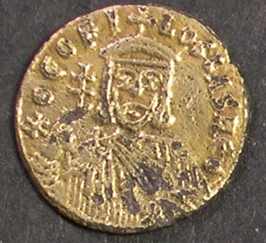
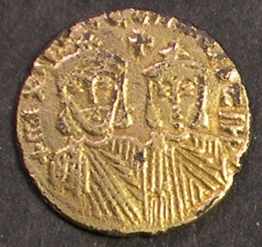
19 mm. 6:00. 2.21 grams. This is far too light for a solidus, which should be about 4.45 grams. I doubt it could have fooled anyone, even when it had all its gilding remaining. So, was it intended to be a deceptive fake worth a real solidus? I am seeking an alternative hypothesis. Perhaps it was jewelry, mounted to make a bracelet or necklace or dancing girl's costume? I now think the "costume jewelry" explanation is correct.
θEFI-LOVS bASILEθ'
Theophilus King (Why don't we spell it with an "f" like he did?)
/MIXAHL S CONSTANTIN
Michael II (his father) and Constantine (his late son)
Another example, from the same group, is below.

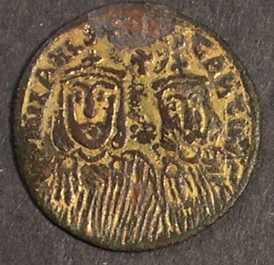
19 mm. 6:00. 1.78 grams.
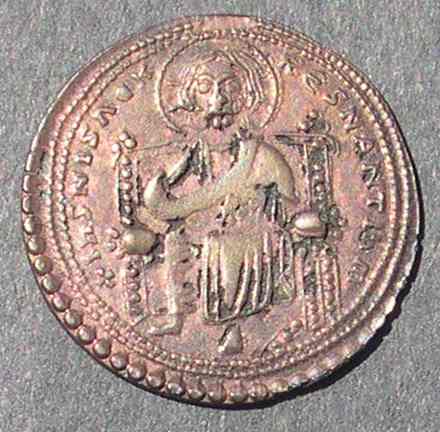
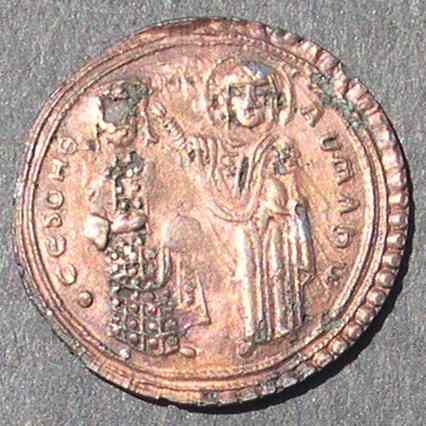
A copper core of a formerly gilt imitation histamenon of Romanus III, 1028-1034 AD.
24-23 mm. 2:00. 2.63 grams.
Sear Byzantine 1819 is the prototype.
Continue with AE imitations of Valentinian I and later.
Return to the main page on Roman imitations.